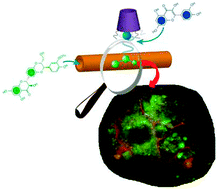Multicavity halloysite–amphiphilic cyclodextrin hybrids for co-delivery of natural drugs into thyroid cancer cells†
Abstract
Multicavity halloysite nanotube materials were employed as simultaneous carriers for two different natural drugs, silibinin and quercetin, at 6.1% and 2.2% drug loadings, respectively. The materials were obtained by grafting functionalized amphiphilic cyclodextrin onto the HNT external surface. The new materials were characterized by FT-IR spectroscopy, SEM, thermogravimetry, turbidimetry, dynamic light scattering and ζ-potential techniques. The interaction of the two molecules with the carrier was studied by HPLC measurements and fluorescence spectroscopy, respectively. The release of the drugs from HNT–amphiphilic cyclodextrin, at two different pH values, was also investigated by means of UV-vis spectroscopy. Biological assays showed that the new complex exhibits anti-proliferative activity against human anaplastic thyroid cancer cell lines 8505C. Furthermore, fluorescence microscopy was used to evaluate whether the carrier was uptaken into 8505C thyroid cancer cell lines. The successful results revealed that the synthesized multicavity system is a material of suitable size to transport drugs into living cells.


 Please wait while we load your content...
Please wait while we load your content...